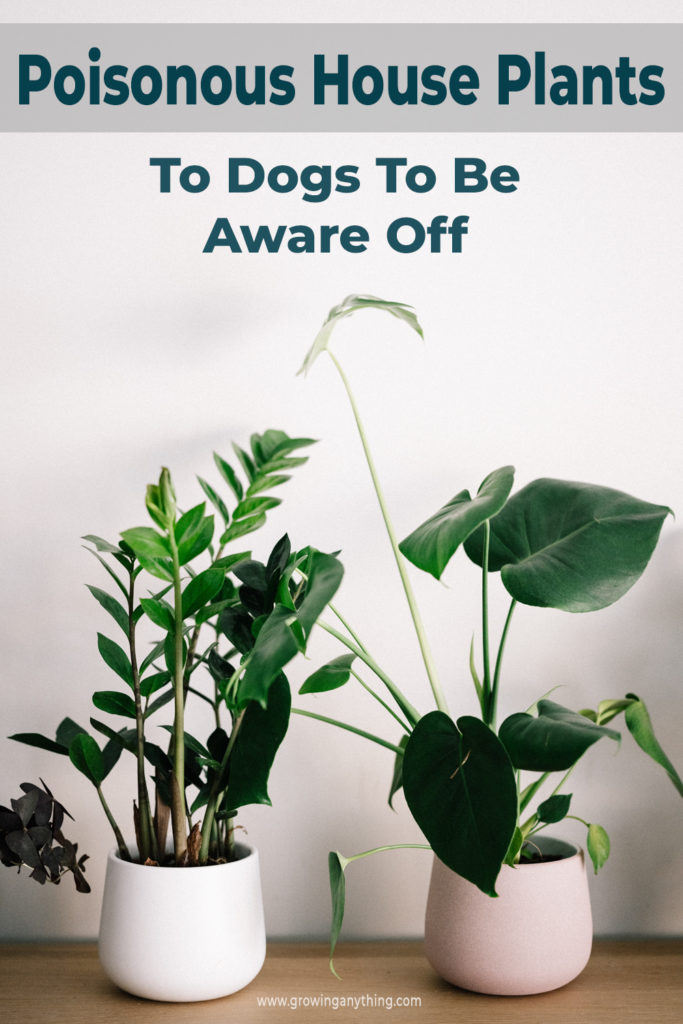21 Poisonous Houseplants for Dogs
Did you know how many poisonous house plants to dogs are in households? If you have dogs or plan to get a puppy, learning more about these toxic plants is recommended.
These plants look attractive and are very popular, but can be toxic, even lethal to dogs. In addition, some plants pose toxic features to cats, dogs, humans, and every being, while others only cause issues to dogs!
Check the following list to find out which plants to move out from your place to keep your canine friend happy and healthy!
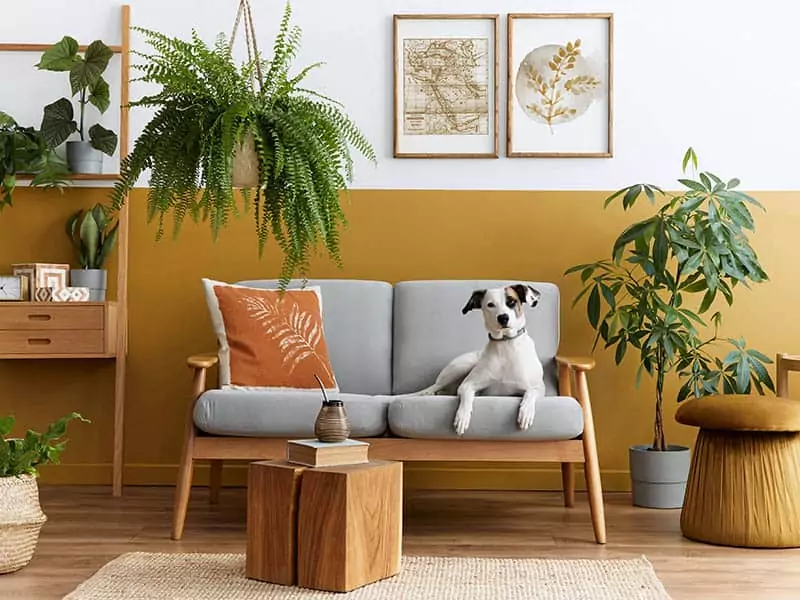
1. Chinese Evergreen
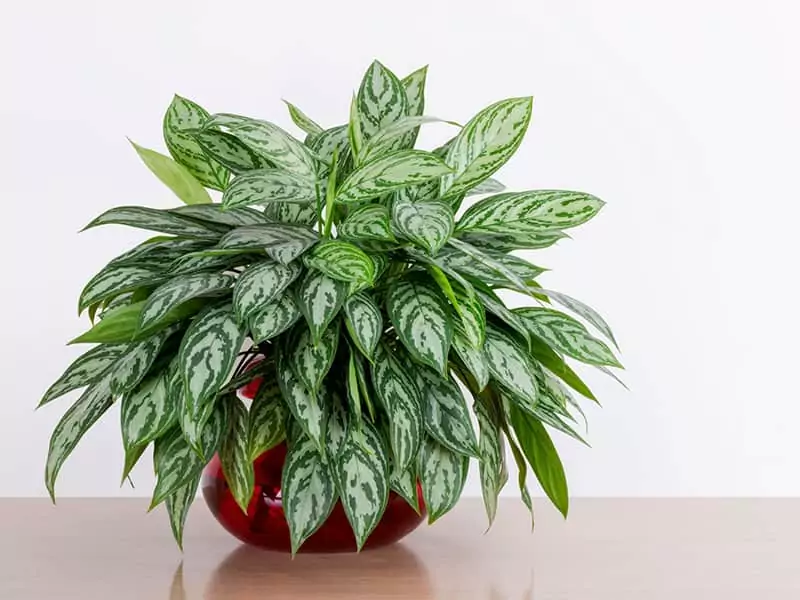
Chinese Evergreen or Aglaonema is one of the most popular evergreen perennial houseplants. It grows erect or as a creeper. The plant thrives in the warm and is sensitive to cold.
However, it is severely toxic to dogs. All parts of the Chinese Evergreen plant contain calcium oxalate crystals, which cause severe irritation and pain when ingested. Luckily, if your dog starts chewing Aglaonema, he will probably stop before he swallows parts because of the immediate irritation.
Cardiac arrhythmia, dilated eyes, and diarrhea are the first symptoms of Chinese Evergreen poisoning in dogs.
The immediate help for poisoned dogs.
2. Bird of Paradise
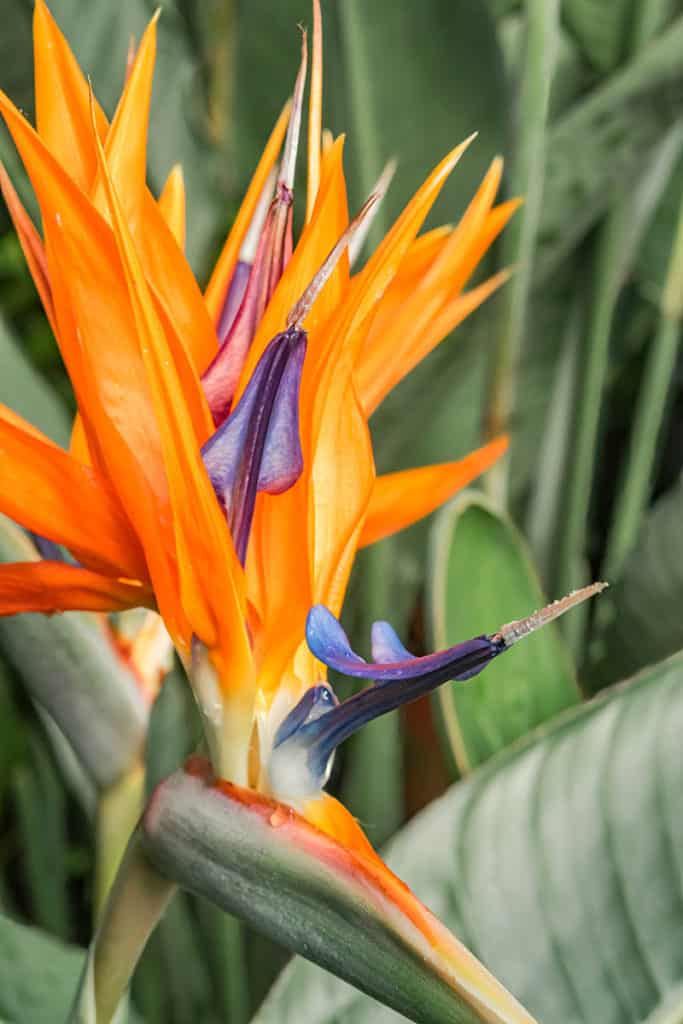
Bird of Paradise is such a wonderful and unusual houseplant. With its fantastic blooms, Bird of Paradise attracts views and arouses admiration. Unfortunately, even a tiny part of Strelitzia is enough to harm your canine friend.
Prussic acid or hydrocyanic acid makes Strelitzia toxic. However, if you respond promptly, a poisonous dog has a high chance of a full recovery. Blooms also contain tannin, another toxic substance to dogs.
3. Asparagus Plant
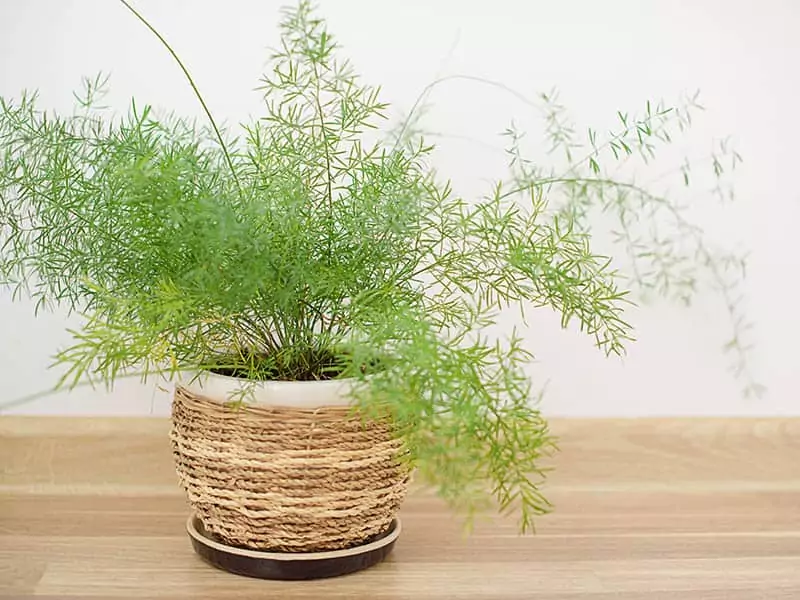
Asparagus is healthy for the human population because of its excellent nutritive value. It doesn’t contain a lot of calories but is rich in vitamins and fibers.
But, your dog should stay away from the Asparagus. When a dog ingests parts of Asparagus plants, vomiting, diarrhea, lack of appetite, and other digestive problems may occur.
Also, don’t give Asparagus to your dog, raw or cooked. Dogs have trouble chewing it and won’t digest it well. You can grill it and serve it as a side dish, but never feed a dog with Asparagus.
4. Elephant Ear
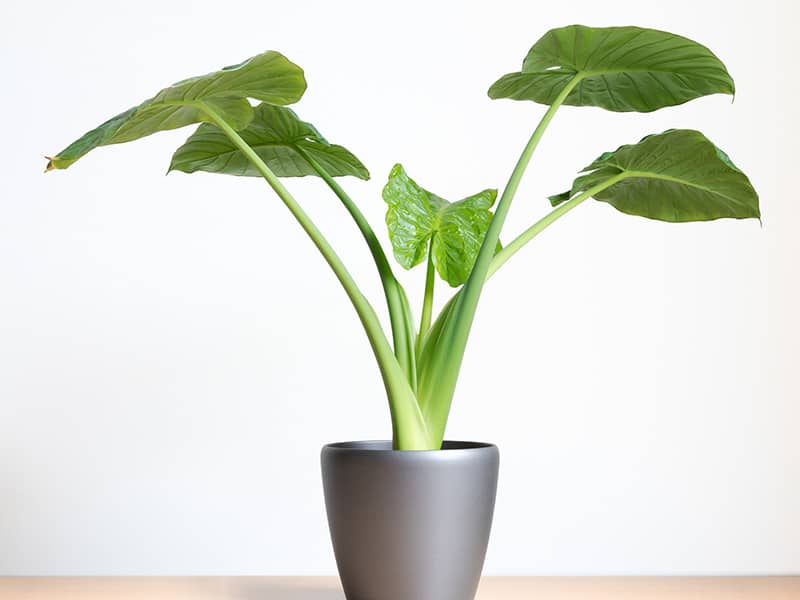
Alocasia or Elephant ears plant feature large and pointy foliage. It is a statement piece in every houseplant collection, but the dogs should stay away from it. Elephant ear plants can be deadly to your dog if he eats any part of the plant.
If you react in time and rinse the dog’s mouth with clean water, it might help. Without reaction, the airway will swell and provoke breathing issues, which can cause death.
Also, the liquid film you can sense on the foliage is irritant. It causes pain and swelling in dogs. So, Elephant Ear plants are definitely not suitable houseplants for homes with pets.
5. Sago Palm
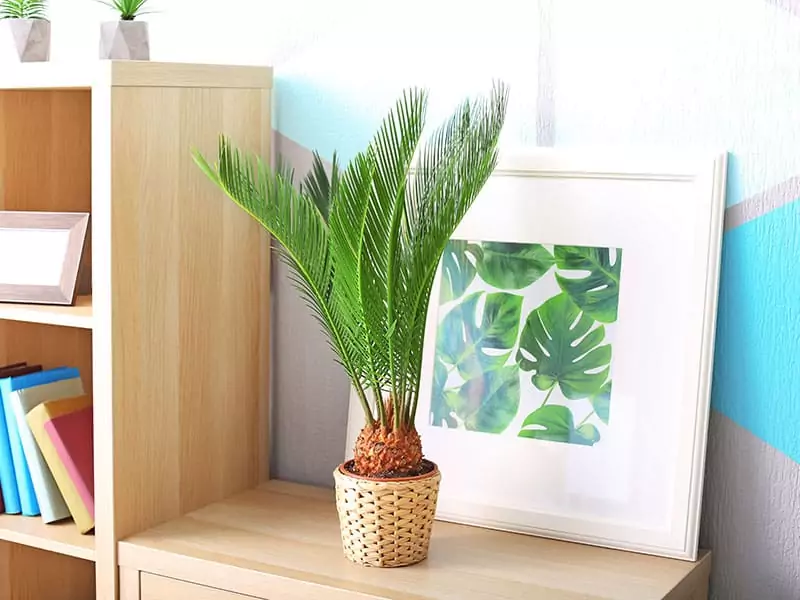
Sago palm is an excellent choice for indoor palm. But, dog owners should stay away from it to keep their furry friends healthy. All parts of the Sago palm are toxic.
Sees are especially harmful because they contain a lot of cycasin, a toxic ingredient in the Sago palm. Cycasin causes liver failure in dogs, as well as digestion issues.
If a dog is exposed to cycasin, in 15 minutes, he will start showing the symptoms of poisoning – drooling, vomiting, diarrhea. Later, severe symptoms occur, such as weakness, seizures, and tremors.
If left untreated, liver failure and eventually death happens within three days of ingestion.
6. Peace Lily
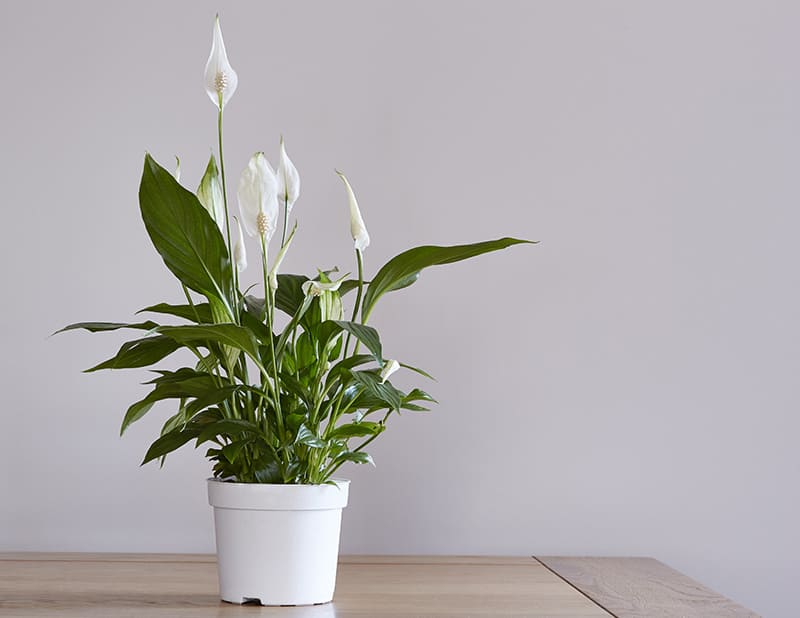
Peace lilies are beautiful indoor plants with charming white flowers and low-maintenance nature. But, Peace lilies are harmful to dogs. Unfortunately, some dogs have the urge to chew Peace lily parts.
Therefore, if you have a dog, it is better to stay away from Peace lily or keep it high above the dog’s reach. A tall shelf might be the solution.
All parts of Peace lily plants – stems, blooms, foliage, roots, and seeds are toxic. The ingredient to blame is calcium oxalate crystal which messes up a dog’s digestive system.
7. Desert Rose
A beautiful Desert Rose is a flowering succulent with thick foliage and bright blooms. Most people grow it indoors because it thrives in warm temperatures.
However, if you grow a puppy indoors, think twice before bringing Desert Rose inside. All parts of the Desert Rose plant cause poisoning in dogs when ingested. The symptoms vary and can be mild to severe.
Digestion issues are considered mild, and cardiac arrest is a rare poisoning symptom. However, it can happen when a dog chews thick Desert Rose foliage and becomes lethal to your canine. When you notice your dog is licking the plant, take him to the vet immediately.
8. Corn Plant
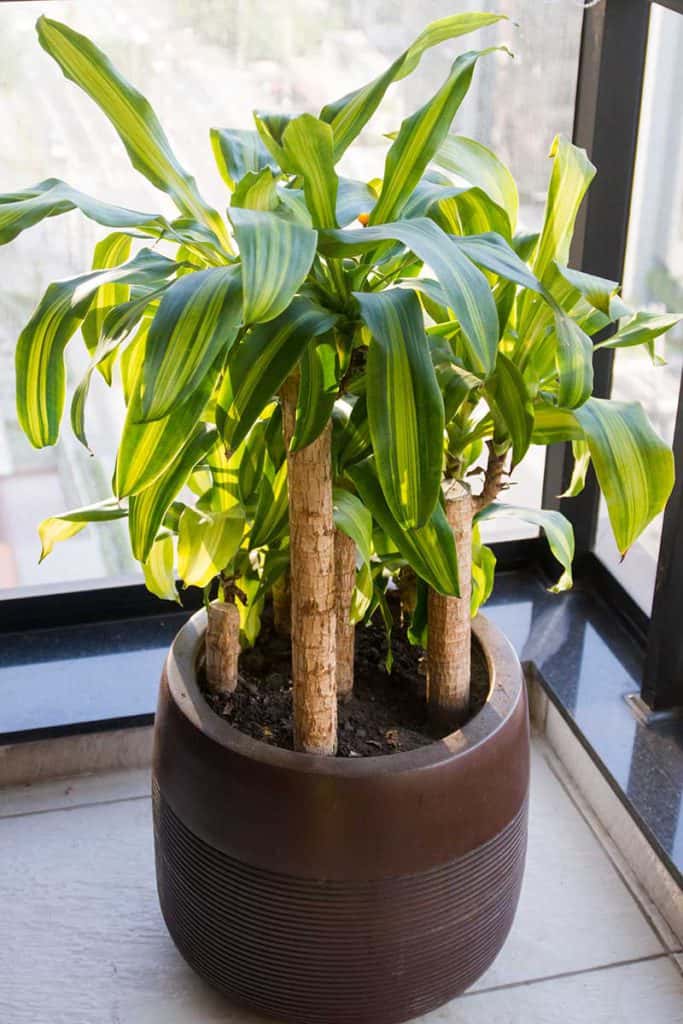
The corn plant is known under many names and has several varieties. They all belong to the Dracaena order and contain certain saponins.
When a dog ingests parts of the Corn plant, classic poisoning symptoms happen. Those include weakness, vomiting, drooling, dilated pupils, and easily noticeable incoordination. Appetite loss and depression are also common symptoms of Corn plant poisoning.
In most cases, dogs react well to prompt reaction and proper treatment. But, to prevent any health issues keep your Corn plant away from four-legged friends!
The Corn plant is also toxic to cats.
9. ZZ Plant
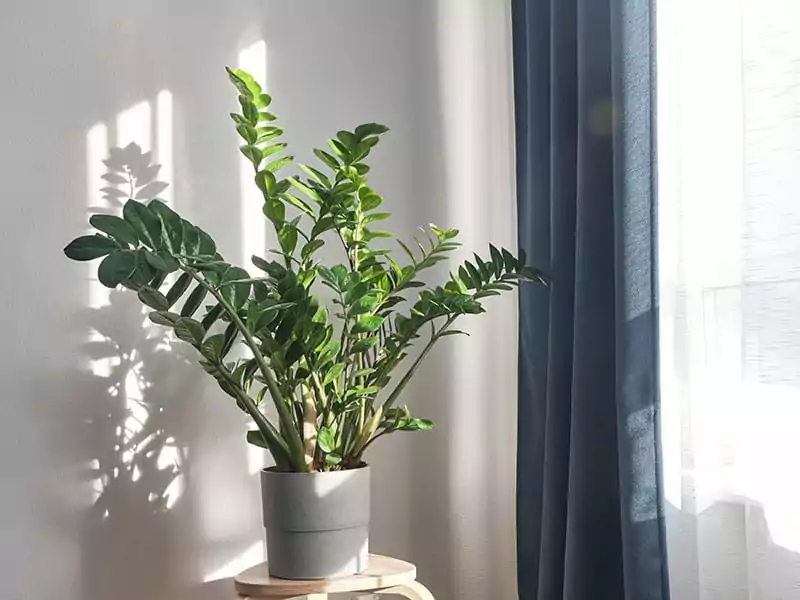
ZZ is a wonderful houseplant, a must-have for all indoor gardeners. Except for the ones with the dogs! ZZ or Zamioculas zamiifolia have attractive foliage, it is drought-tolerant and can grow in low light.
But, the ZZ plant is poisonous to pets and humans. Even though the symptoms aren’t lethal, the ZZ plant can still cause severe discomfort in dogs when they ingest the sap that foliage produces.
You should also wear gloves when taking care of the plant because the sap causes skin irritations.
Calcium oxalate is another irritant in the ZZ plant, untraceable under the naked human eye. But, it can cause stomach issues in dogs.
10. Aloe Vera
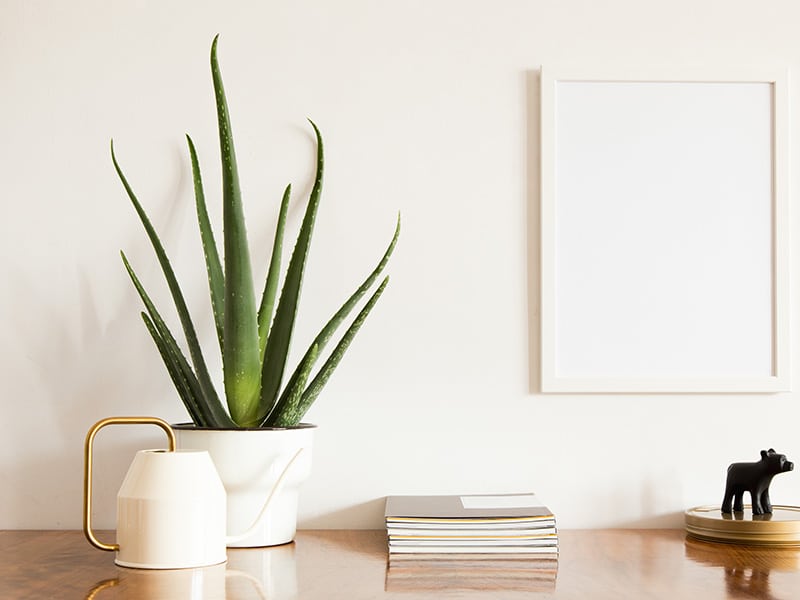
Aloe vera is another easy-care succulent that only lives in warm weather climates. Outside warm zones, people grow Aloe vera with great success indoors.
Unfortunately, this versatile and beneficial succulent contains anthraquinone glycosides. These substances are known to encourage bowel movement and are called purgatives.
When your dog eats part of Aloe vera, it causes water in the colon, which leads to diarrhea, and vomiting. Side effects are also depression, anorexia, changes in urine color. Sometimes, dogs who have swallowed Aloe vera may experience tremors as another symptom.
If you suspect the dog may have eaten parts of Aloe vera, take him to the vet immediately.
11. Dumb Cane
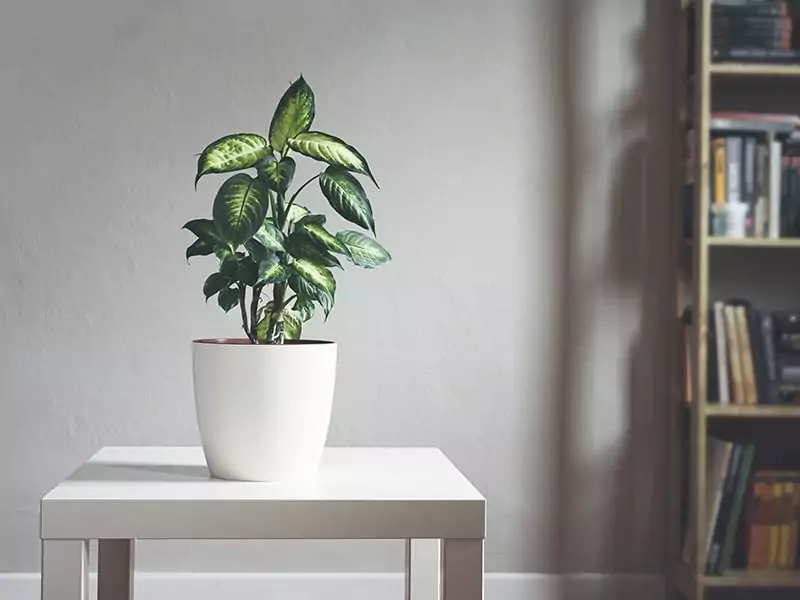
Dieffenbachia is a beautiful, tropical plant and one of the most common houseplants because they are tolerant of shade. However, Dieffenbachia isn’t safe to keep around pets, especially dogs.
The plants are known to cause oral mucosa and stomach issues because foliage and stems contain a high percentage of oxalate crystals.
Minutes after eating Dieffenbachia, your pet will feel painful sensations in its mouth. Luckily, it will stop them from eating too much. The intoxication signs in dogs are swelling, drooling, and breathing issues in severe cases.
12. Jade
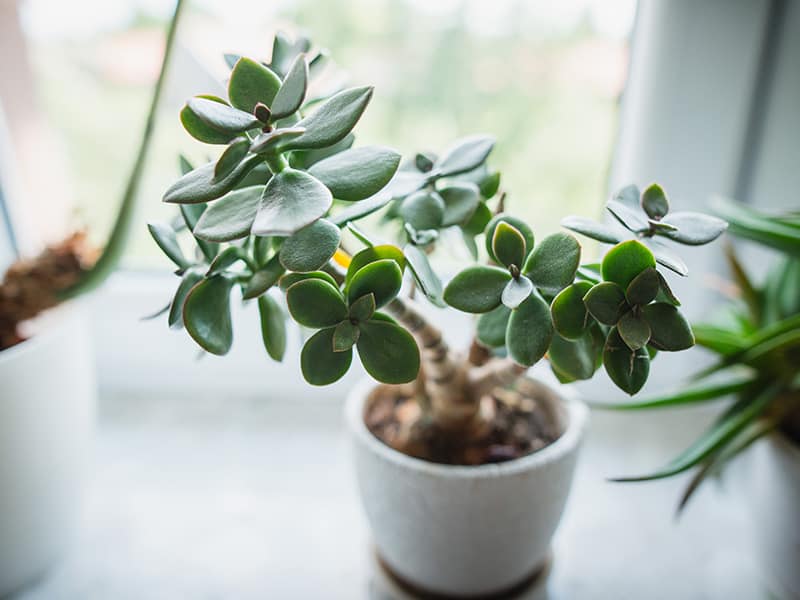
Jade is a wonderful succulent, best known for its stunning foliage and star-shaped blooms. It is compact so it can fit in small apartments. There are lots of Jade varieties, and all of them are toxic to dogs.
Consuming Jade plants causes problems with the digestive system, heart issues, and depression in dogs. The first signs that your dog might have been poisoned by the Jade plant are clumsy movements, vomiting, and lethargy.
Luckily, poisoning by the Jade plant rarely causes severe health issues in your canine friends. But, take the dog immediately to a vet if you suspect the dog ate any part of Jade. However, if you believe in the saying Better safe than sorry, I recommend not holding Jade in your home at all!
13. Philodendron
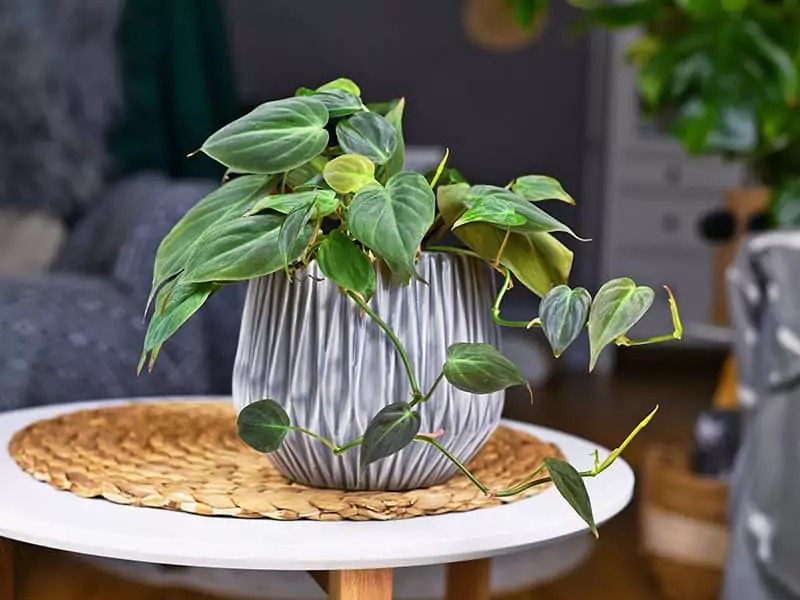
Philodendron is severely toxic to dogs. Respiratory and digestive distress caused by the consumption of Philodendron can be fatal to your dog, so prompt reaction is essential for saving your dog’s life.
In most cases, a dog starts drooling, choking, and foaming immediately after eating Philodendron. Then, you must take the dog to the vet immediately.
Don’t wait for severe poisoning symptoms such as convulsions, renal failure to appear to go to the vet. Ultimately, the dog will get into a coma and die if it doesn’t receive medical treatment.
Flushing the dog’s mouth with water and giving him something with calcium might help, but only a vet will provide the necessary treatment.
14. Ivy
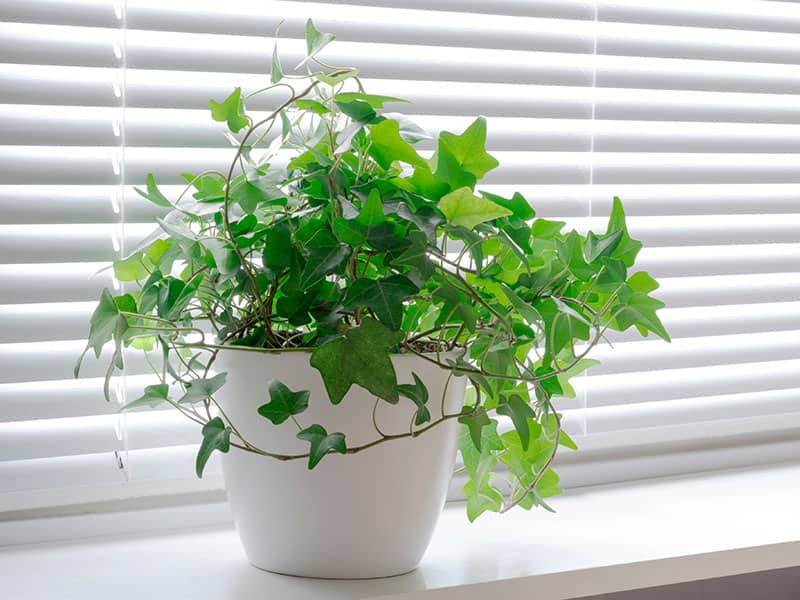
Hedera helix or Ivy is a common outdoor plant, but you can also grow it indoors. But, if you have a dog, most people will advise you to keep your Ivy out of the dog’s reach. The entire Ivy plant is toxic, and the foliage contains the highest percentage of toxins.
Hedera helix can cause a dermal reaction when a dog gets in contact with the plant. When a dog eats Ivy leaves or stems, he will experience digestion issues.
What to know when a dog eats Ivy.
15. Pothos
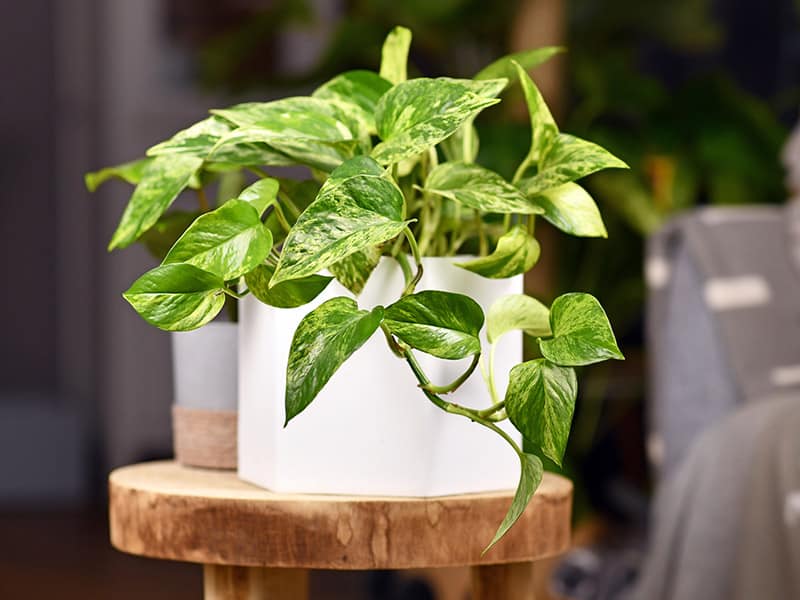
Pothos aka Epipremnum aureum isn’t a pet-friendly plant. Stems and leaves contain calcium oxalate crystals, known to cause burning and painful sensations in a dog’s mouth.
So, instead of growing Pothos in your home, bring them to the office. It is a low-care plant that will grow well in most conditions and decorate every office corner.
16. Kaffir Lily
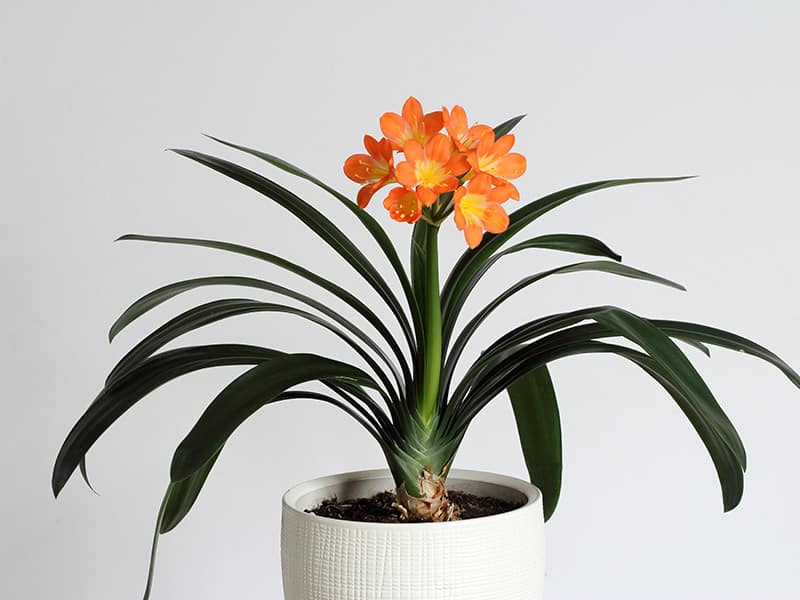
A beautiful Kaffir Lily has succulent foliage, but it is praised for bunched flowers. In most cases, Kaffir Lily has orange flowers.
The plant is severely toxic to cats, but can also cause health issues to your dog. Bulbs are the most toxic parts of Kaffir Lily because they contain alkaloids and lycorine.
If a dog eats Kaffir Lily, it can cause vomiting, hypotension, tremor, seizure, cardiac distress.
Immediate medical treatment is essential for preventing severe poisoning consequences.
17. Alocasia
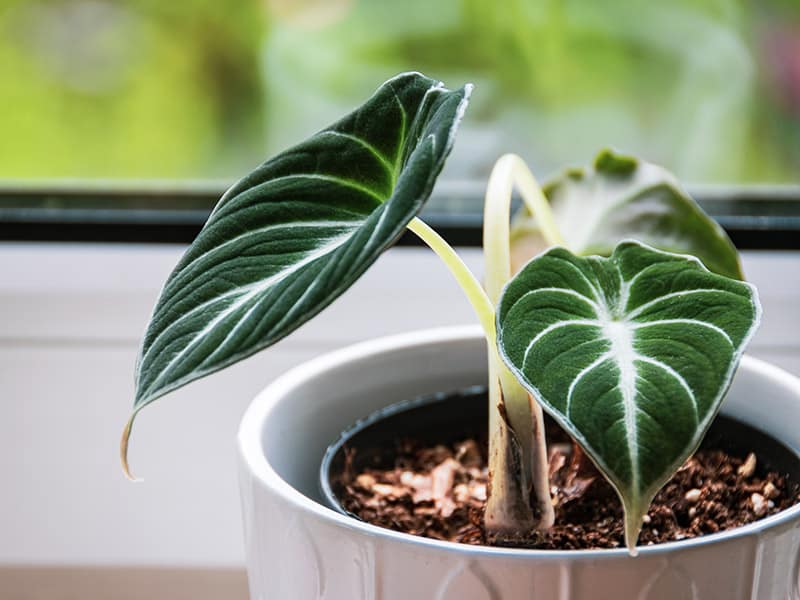
Alocasia is another common houseplant that contains a lot of calcium oxalate crystals. Therefore, it is best to keep the plant away from your dog to prevent health issues.
Sometimes, symptoms of Alocasia poisoning in dogs may last up to two weeks, until the dog’s system is fully clean of the toxins.
Leaves, flowers, and stems are a threat to your dog, so lift the plant on a tall shelf if you want to grow it indoors.
18. Cyclamen
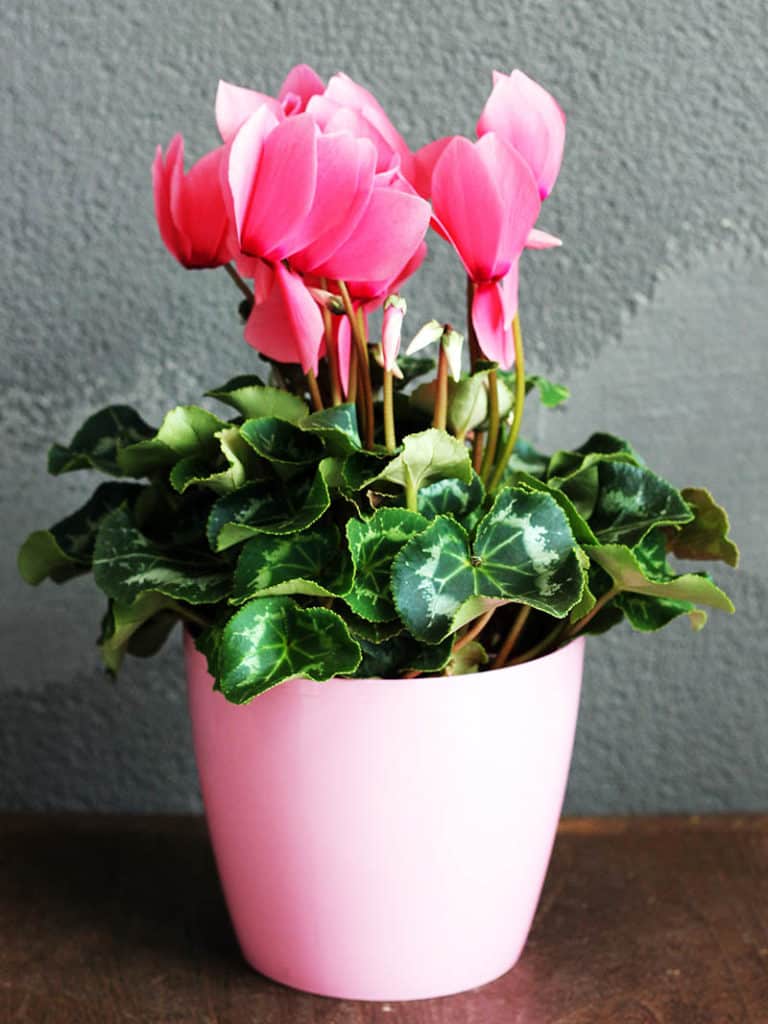
I love Cyclamen, because of its compact size and beautiful appearance over the winter and in spring. Unfortunately, Cyclamen is one of the popular houseplants with toxic components.
The tubers in the soil are highly toxic and can cause severe health issues when ingested. Luckily, your pet needs to swallow a large amount of Cyclamen tubers to develop severe clinical issues.
In most cases, the symptoms are mild and easily manageable.
Common poisoning symptoms in dogs.
19. Arrowhead
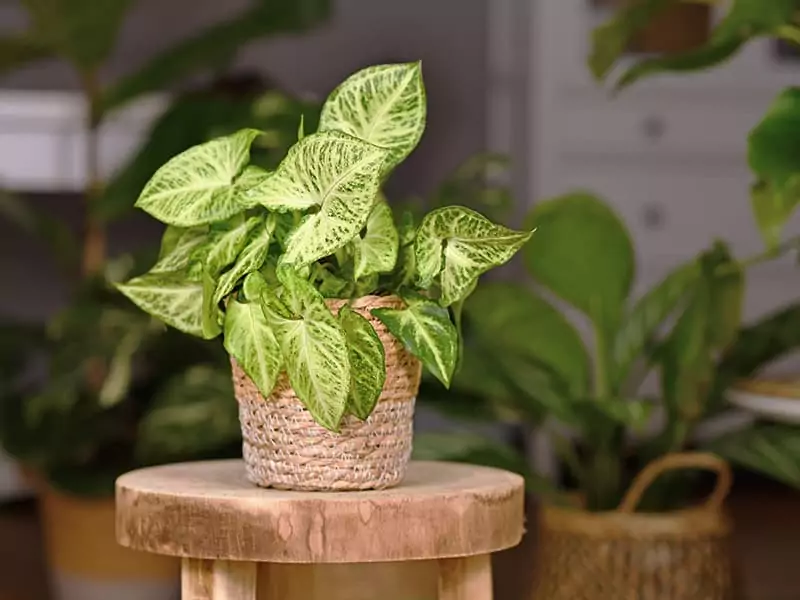
Arrowhead got the name because of the distinctive and easily recognizable foliage. It is a relatively easy plant to grow in most household conditions and looks beautiful in hanging pots.
However, the Arrowhead vines sometimes can be attractive to your dog, so he can sniff around and chew them.
The symptoms occur soon after chewing the Arrowhead plant and include dilated pupils, drooling, vomiting, hoarse barking, and airway obstruction. If you notice any symptoms, consider it an emergency and take your dog to the vet as soon as possible.
The prognosis is good in most cases, after the prompt reaction.
20. Calla Lily
If you are growing Calla lily at home or someone has brought you a Calla lily bouquet, keep it away from your dog to prevent health issues. If a dog eats Calla lily, he will experience excessive drooling, mouth swelling, seizures, vomiting, and pain.
The severity of the poisoning depends on the amount of plant a dog digests. The toxic ingredients in Calla lily are infamous calcium oxalate crystals, which I already mentioned as common toxin agents in houseplants.
21. Kalanchoe
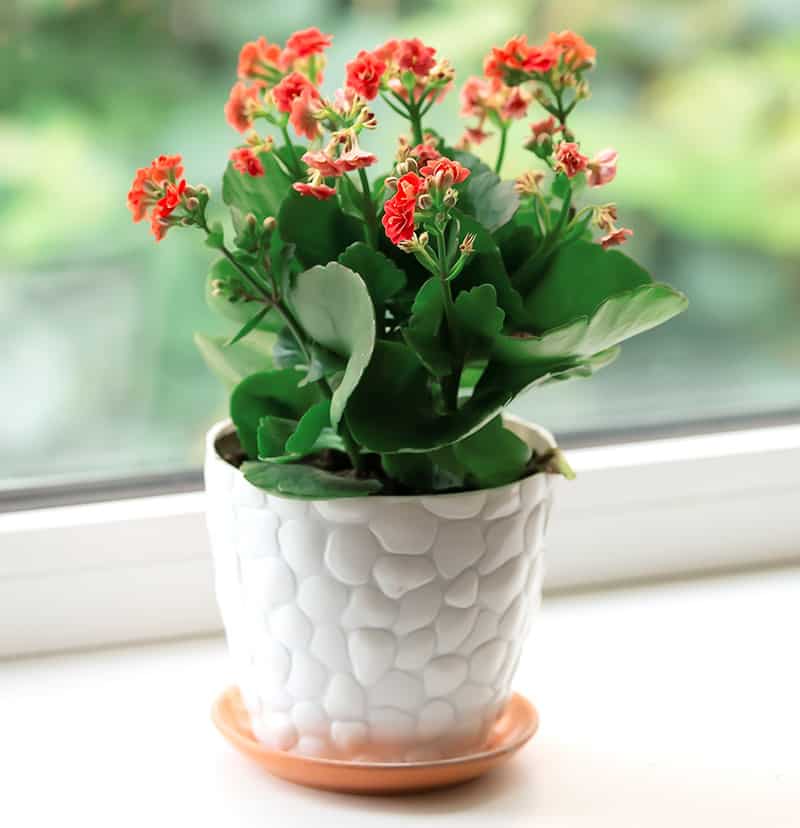
With its charming flowers and compact size, Kalanchoe is a common houseplant. Kalanchoe can handle various conditions, but dogs cannot tolerate Kalanchoe. It can make them severely sick. Kalanchoe is also toxic to all other pets, but luckily humans aren’t at any risk.
Usually, it takes several hours for a dog to show symptoms of Kalanchoes poisoning. Typically, those include the upset digestive system, vomiting, cardiac arrest. If you don’t provide medical help soon, a dog may die from Kalanchoe poisoning.
Pick Your Plants Wisely
There are so many wonderful houseplants that aren’t poisonous to dogs. My favorites are African violets, Spider plant, and Money tree!
So, you can skip the above-mentioned toxic plants to dogs and raise your dog in a safe environment! If you cannot resist some of the toxic plants, keep them at the highest point where your dog cannot reach them.
Has your dog ever eaten something forbidden? How did you react?
Please share your thoughts on my list and back for more practical gardening articles!
